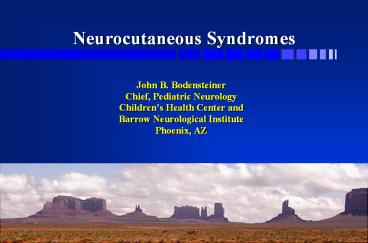Neurocutaneous Syndromes - PowerPoint PPT Presentation
1 / 22
Title:
Neurocutaneous Syndromes
Description:
Neurocutaneous Syndromes John B. Bodensteiner Chief, Pediatric Neurology Children s Health Center and Barrow Neurological Institute Phoenix, AZ Sturge-Weber ... – PowerPoint PPT presentation
Number of Views:339
Avg rating:3.0/5.0
Title: Neurocutaneous Syndromes
1
Neurocutaneous Syndromes
- John B. Bodensteiner
- Chief, Pediatric Neurology
- Childrens Health Center and
- Barrow Neurological Institute
- Phoenix, AZ
2
Sturge-Weber Syndrome
- Primary features
- Port-wine stain
- Facial, unilateral or bilateral,
- Meningeal angiomatosis
- Ipsilateral to PWS or bilateral, rarely
contralateral - Glaucoma
- Congenital Bupthalmos
- Scleral angiomatosis
- Anterior chamber anomaly
- Increased production of humor
essential for diagnosis of SWS
3
PWS
- Capillary angioma
- Site determines response
- Glabellar skin responds best
- Distribution does not determine the presence of
meningeal angioma - upper lids and bilateral lesions have greater
risk
4
PWS
- Lesion may thicken with age
- Nodularity develops with age/puberty
- Other tissues may be involved
- Teeth
- Jaw
- Tongue
- Nasal passages
- Trunk
- Arms
5
PWS
- Estimated that 90 of PWSs do not have
Sturge-Weber syndrome - Even with bilateral lesions most do not have SWS
- This child does not have SWS
- Tuned laser surgery may prevent thickening of
skin and subcutaneous tissues
6
SWS
- Neurological features
- Seizures
- 50 by 1 year, 90 by 5
- Early onset associated with worse prognosis for
- Control of seizures
- Cognitive function
- Hemiparesis
- May develop in stroke like events
- Often associated with Seizure flurries
- Cognitive impairment/LD
7
Axial MRI of child with Sturge-Weber syndrome
showing atrophy of the left hemisphere and
contrast enhancement of the surface of the left
hemisphere particularly prominent over the
occipital lobe.
8
Coronal and axial MRI of a child with
Sturge-Weber syndrome showing the extent of
atrophy resultant from this extensive left
hemisphere meningeal angioma.
9
Sagittal MRI with contrast from a 13 year old
with extensive meningeal angioma over the left
hemisphere, note the contrast enhancement of the
gyral pattern and the enlargement of the deep
venous system secondary to the increased flow
through the extensive lesion.
10
Timing of Neuroimaging
- One year-old
- Scanned at one month, told there was no
intracranial involvement - Consensus is that if by 1 year there is no
evidence of intracranial involvement there is no
SWS
11
Tram Track Calcifications
12
Gross and Microscopic lesions
13
SWS Eye
- Conjunctival angiomatosis
- Scleral angiomatosis
- Glaucoma
- CongenitalBupthalmos
- Secondary to
- Sclera angiomata
- Anomaly of Schlemms canal
- Increased resistance to absorption of fluid
14
Scleral Angiomatosis
15
Schlemms Canal
16
Optic Nerve Damage, IOP
Moderate ON damage
Advanced ON damage
17
Retinal involvement
Vascular tortuosity of retinal vessels on
affected side
18
Glaucoma
- Age of onset lt1 to 43 years
- Total 60,
- Unilateral 57 Bilateral 43
- Highly associated with V1 and V2 distribution
lesions - Several mechanisms involved
- Anomaly of Schlemms canal
- Choroidal angioma
- Increased pressure of drainage
19
SWS Controversies
- Pathophysiology of functional deterioration
- Hypoxic-Ischemic injury
- Vascular Steal
- Stroke?
- Hemorrhage?
- Management of Seizures
- Indications for surgical Rx of seizures
- Choice of operation
- Diagnosis in Infancy
20
Surgical Rx of Seizures
- Medically refractory and functionally intrusive
seizures! - Lesionectomy
- Small circumscribed lesion demonstrated source of
seizures - Callosotomy
- Drop attacks, uncommon but very refractory when
present - Hemispherectomy
- Timing controversial
- Type of operation ?controversial?
21
Hemispherectomy
- Intrusive seizures
- Medically refractory Sz
- Unilateral hemisphere involvement (Not an
absolute requirement of other factors match) - Age appropriate facility with available
- CT, MR, MR Spectroscopy, Video EEG monitoring
capability, Invasive monitoring capability, PET
availability - Already established, Lesion related neurological
deficit!
22
(No Transcript)

